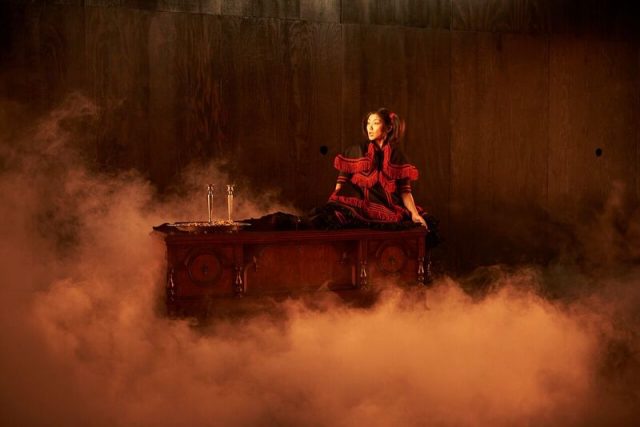

Since the era of the Bronte sisters, the moors of England have inspired a literary tradition deeply rooted in their otherworldly nature. The Moors, the tellingly named new play from the Playwrights Realm at the Duke on 42nd, adopts this tradition as its own. Capturing the eeriness of the moors, playwright Jen Silverman uses the play’s setting as its defining element, drawing from the isolation and menacing power of the moors to delineate the tone of the play.
Emilie (Chasten Harmon) has just arrived at a house on the moors to work as the family’s new governess. However, nothing is quite as it should be: the master of the house, who wrote her letters to hire her, is strangely absent, and she has yet to meet the child she is supposed to be caring for. She has more pressing things to wonder about, though, since the whole house seems to be made of nothing but oddities and mysteries. Agatha (Linda Powell), cold and strict, seems to dislike her, while her childish sister Hudley (Birgit Huppuch), who constantly strives for attention, talks about nothing but how secret her diary must be kept, yet constantly tries to corral Emilie into listening to it read aloud. More baffling still, the scullery maid Mallory (Hannah Cabell) is clearly the same person as the scullery maid Marjory, just wearing a different hat, but everyone insists that they’re two separate people.
Amidst all this, the house itself presents a creepy facade and a creepier interior life. Marjory takes Emilie on a strange tour of the house, always seeming to present the same room with a different function. “Surely, this is the parlor?” Emilie asks when Marjory takes her from aforementioned parlor to her bedroom, an identical room furnished with two chairs and a table, and a conspicuous lack of a bed. Dane Laffrey’s sparse and imposing set design makes this recurring gag all the eerier as various characters declare themselves to be in different rooms -- The great hall! The second sitting room! The dining room! -- while always stepping out onto the same stage.
It is this unwillingness of the characters to acknowledge the obvious realities before them -- or perhaps Emilie’s unwillingness to go along with their fantasy -- that lends The Moors its special blend of humor and eeriness. The goings-on inside the house would feel ridiculous, with the maid switching hats and personalities in one swift motion and a grown woman moving on to the next day in her diary whenever she has a new emotion, regardless of the actual passage of time, if not for the setting. Whenever fog spills over the imposing center table and overtakes the stage, the wild savagery of the moors becomes evident, and, contrasted with Laffrey’s stiff design for the house, lends the play’s strange comedy a sinister weight.
Some parts of the play are not as successful. A storyline in which the household’s lonely and existential mastiff (Andrew Garman) meets and falls in love with a moor-hen (Teresa Avia Lim), though well acted, expresses some of the play’s central themes a little too directly, and, plot-wise, the link between theirs and the main story is difficult to find. However, under Mike Donahue’s direction, the performances across the board highlight the unearthly wilderness of the moors while still drawing laughs from the audience with the fantasies and oddities that come from life in the isolated -- and dangerous -- fog that encompasses everything around them.